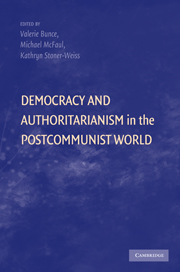Book contents
- Frontmatter
- Contents
- Prologue
- PART I WAVES OF REGIME CHANGE: FROM DICTATORSHIP TO DEMOCRACY…AND BACK?
- PART II ENCOURAGING DEMOCRACY: THE ROLE OF THE EUROPEAN UNION
- PART III CHOOSING REGIME CHANGE: DEMOCRATIZING ELECTIONS
- PART IV RESISTING REFORM: BACKSLIDING DEMOCRACIES AND ENDURING AUTOCRACIES
- 9 Resistance to Contagion
- 10 Comparing Oranges and Apples
- 11 Contagion Deterred
- 12 A Horse of a Different Color
- Epilogue
- Index
- References
10 - Comparing Oranges and Apples
The Internal and External Dimensions of Russia's Turn away from Democracy
Published online by Cambridge University Press: 05 June 2012
- Frontmatter
- Contents
- Prologue
- PART I WAVES OF REGIME CHANGE: FROM DICTATORSHIP TO DEMOCRACY…AND BACK?
- PART II ENCOURAGING DEMOCRACY: THE ROLE OF THE EUROPEAN UNION
- PART III CHOOSING REGIME CHANGE: DEMOCRATIZING ELECTIONS
- PART IV RESISTING REFORM: BACKSLIDING DEMOCRACIES AND ENDURING AUTOCRACIES
- 9 Resistance to Contagion
- 10 Comparing Oranges and Apples
- 11 Contagion Deterred
- 12 A Horse of a Different Color
- Epilogue
- Index
- References
Summary
What we thought would be easy, turned out to be very difficult.
– Boris Yeltsin, December 31, 1999 upon resigning as President of RussiaWhen Vladimir Putin was elected president of Russia in March 2000, the country bequeathed to him by his predecessor, Boris Yeltsin, was an unconsolidated, often disorderly and raucous electoral democracy. Gradually, the Russian political system under Putin came to be described first as “managed democracy,” then as “illiberal democracy” or “delegated democracy,” and finally, by 2008, and the ascendancy of a new hand-picked Russian president, Dmitri Medvedev, as not really a democracy at all. What happened? Why did the fourth wave miss Russian shores? Is Russia immune to the diffusion effect of democratization that swept the East in the late 1980s and that again moved eastward from Serbia, Ukraine, and Georgia? What prospects are there for external factors to play a role in bringing about a rejuvenation of democracy in Russia?
I examine these questions in the three main sections of this chapter. Section I examines the internal political, social, and economic factors that have contributed to the growing momentum of the reverse wave in Russia. This section notes that most of the crucial factors that brought about the color revolutions elsewhere were for the most part absent within the Russian domestic political, social, and economic context. Section II then looks at the role of external factors and the international environment in promoting democracy versus an authoritarian reversal in the past and present.
- Type
- Chapter
- Information
- Democracy and Authoritarianism in the Postcommunist World , pp. 253 - 273Publisher: Cambridge University PressPrint publication year: 2009
References
- 3
- Cited by



